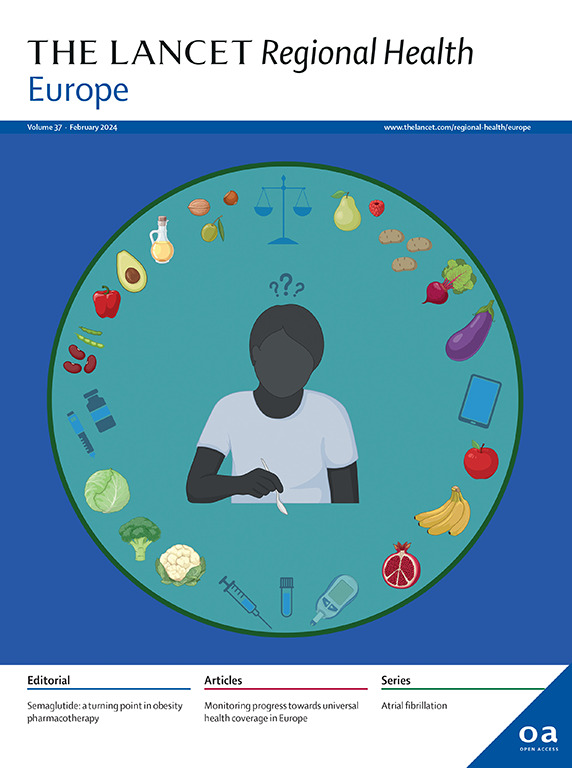乳糜泻患者慢性肝病的长期风险:一项基于全国人群的、兄弟姐妹对照队列研究
IF 13.6
Q1 HEALTH CARE SCIENCES & SERVICES
引用次数: 0
摘要
背景乳糜泻(CeD)可能与肝酶升高有关。然而,对于慢性肝病(CLD)的各种病因或主要不良肝脏结局(MALO)的风险知之甚少。我们的目的是调查CeD患者发生CLD的长期风险。方法:瑞典全国队列研究。我们在1969年至2017年期间确定了48,027例活检证实的CeD患者。每名患者与≤5名一般人群参考个体(n = 231,909)精确匹配,随访至2021年。灵活参数生存模型估计任何和特定CLD(即病毒性肝炎、代谢功能障碍相关脂肪变性肝病[MASLD]、酒精相关肝病和自身免疫性肝病)和MALO(代偿/失代偿肝硬化、肝细胞癌、肝移植和肝脏相关死亡)的调整风险比(aHRs)。在中位随访16.0年期间,649例CeD患者和1571例对照个体发生了CLD(发病率:79.4 vs 39.5/100,000人年)。CeD患者发生任何CLD的风险高于对照组(aHR = 2.01, 95%CI:1.82−2.22)。在诊断后≥25年,这一风险仍然升高,在此之前,每110名CeD患者中有1例额外的CLD病例。自身免疫性肝病(aHR = 4.86)、MASLD (aHR = 2.54)和酒精相关性肝病(aHR = 1.51)存在正相关。患有CeD的个体发生MALO的风险明显更高(aHR = 1.54)。同胞比较和敏感性分析证实了主要发现。尽管绝对风险很低,但interpreationced与任何突发CLD的风险持续增加有关。医生应警惕CeD患者肝功能障碍的早期迹象。资助:欧洲克罗恩病和结肠炎组织、瑞典医学研究学会(项目编号:PG-23-0315-H-02)、FORTE(项目编号:2016-00424)、武田和瑞士国家科学基金会(项目编号:P500PM_210866)。本文章由计算机程序翻译,如有差异,请以英文原文为准。
Long-term risk of chronic liver disease in patients with celiac disease: a nationwide population-based, sibling-controlled cohort study
Background
Celiac disease (CeD) may be associated with elevated liver enzymes. However, little is known about the risk of chronic liver disease (CLD) of various etiologies or major adverse liver outcomes (MALO) in CeD. We aimed to investigate the long-term risk of CLD in patients with CeD.
Methods
Swedish nationwide cohort study. We identified 48,027 patients with biopsy-confirmed CeD between 1969 and 2017. Each patient was exactly matched with ≤5 general population reference individuals (n = 231,909) and followed through 2021. Flexible parametric survival models estimated adjusted hazard ratios (aHRs) of any and specific CLD (i.e., viral hepatitis, metabolic dysfunction-associated steatotic liver disease [MASLD], alcohol-related liver disease, and autoimmune liver disease) and MALO (compensated/decompensated cirrhosis, hepatocellular carcinoma, liver transplantation, and liver-related death).
Findings
During a median follow-up of 16.0 years, 649 patients with CeD and 1571 reference individuals developed any CLD (incidence rate: 79.4 vs. 39.5/100,000 person-years). CeD patients had a higher risk of developing any CLD than reference individuals (aHR = 2.01, 95%CI:1.82−2.22). This risk remained elevated ≥25 years after diagnosis, giving one extra CLD case per 110 CeD patients until then. Positive associations were present for autoimmune liver disease (aHR = 4.86), MASLD (aHR = 2.54), and alcohol-related liver disease (aHR = 1.51). Individuals with CeD were at significantly higher risk of incident MALO (aHR = 1.54). Sibling comparisons and sensitivity analyses confirmed the main findings.
Interpretation
CeD is associated with a persistently increased risk of any incident CLD, although the absolute risk is low. Physicians should be vigilant to early signs of liver dysfunction in patients with CeD.
Funding
European Crohn's and Colitis Organisation, the Swedish Society for Medical Research (project#: PG-23-0315-H-02), FORTE (project#: 2016-00424), Takeda, and the Swiss National Science Foundation (project#: P500PM_210866).
求助全文
通过发布文献求助,成功后即可免费获取论文全文。
去求助
来源期刊

Lancet Regional Health-Europe
Multiple-
CiteScore
19.90
自引率
1.40%
发文量
260
审稿时长
9 weeks
期刊介绍:
The Lancet Regional Health – Europe, a gold open access journal, is part of The Lancet's global effort to promote healthcare quality and accessibility worldwide. It focuses on advancing clinical practice and health policy in the European region to enhance health outcomes. The journal publishes high-quality original research advocating changes in clinical practice and health policy. It also includes reviews, commentaries, and opinion pieces on regional health topics, such as infection and disease prevention, healthy aging, and reducing health disparities.
 求助内容:
求助内容: 应助结果提醒方式:
应助结果提醒方式:


